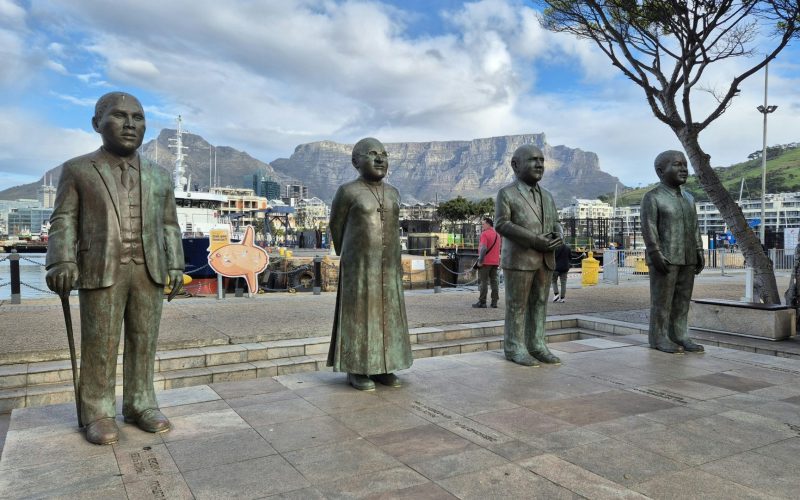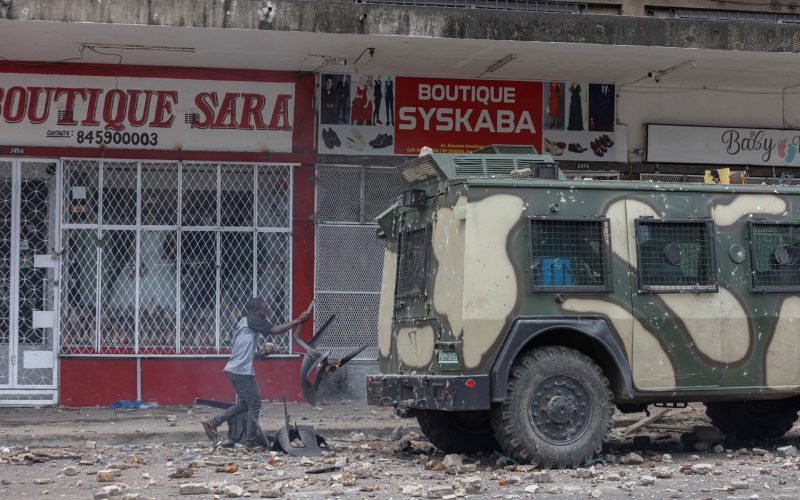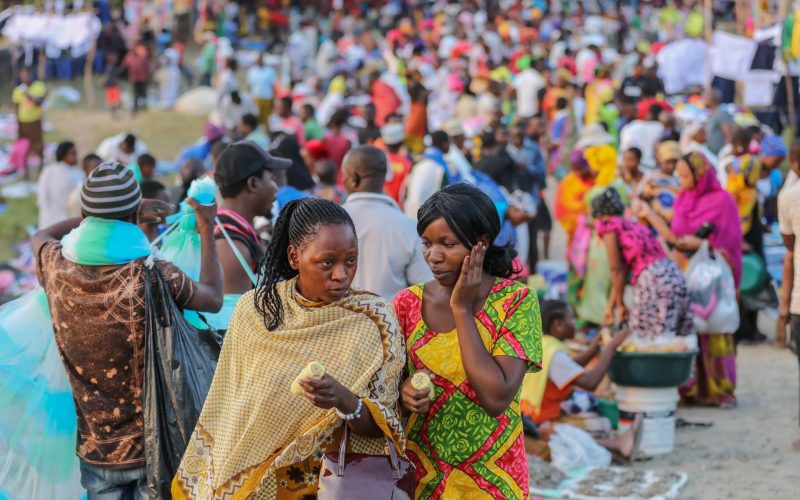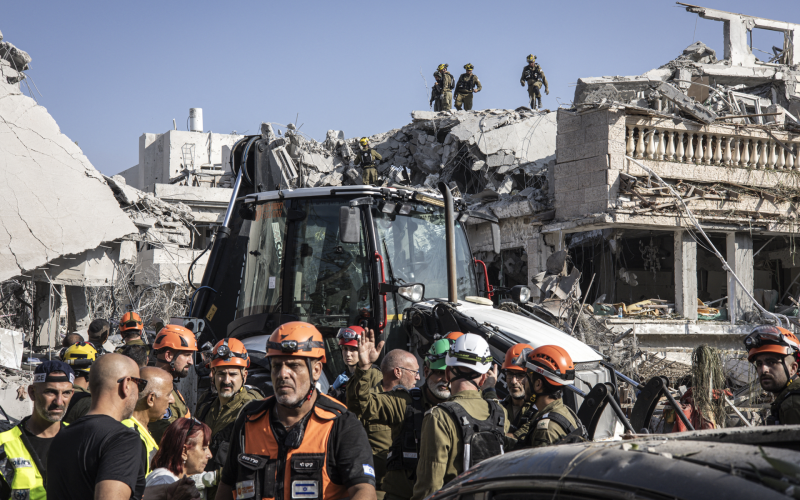Big African states are among the least successful on the continent. Countries with a large land mass and sizeable population tend to be chronically unstable. They perform poorly economically, even thought many are rich in natural resources and all have established internal markets. They have been among the least successful in overcoming the early post-colonial legacy of single-party or military regimes and in moving toward democracy. Forty-plus years after independence, most are still struggling to find a political system capable of holding together their diverse populations.
Nigeria, the Democratic Republic of Congo, Ethiopia, Sudan, and Angola together account for about 40 percent of the population of Sub-Saharan Africa. Their chronic internal problems have repercussions that go well beyond their boundaries. The disintegration of the DRC has had particularly devastating consequences, affecting all the neighboring countries and even pulling in some farther afield. Sudan and Ethiopia have meddled dangerously in each other’s civil wars for decades, destabilising the entire Horn of Africa. War in the southern Sudan has a spillover effect in Uganda. Angola, which has the potential for rapid economic growth, instead exports refugees. And Nigeria, which aspires to play the role of benevolent hegemon stabilizing West Africa, perennially teeters on the verge of an internal collapse.
The only true exception is South Africa. Though still facing a host of major socioeconomic problems, South Africa is a functioning state with both the strong administrative system and the transport and communication infrastructure that allow modern states to implement policies, collect taxes, and deliver services in return. The unity of the state is not contested by its citizens. Although the dominant role of the African National Congress hampers true political competition, the country has developed a more stable political system than any other large African states.
To be sure, many small and medium states in Africa also perform poorly and their internal conflicts are sometimes intertwined. But the problems of smaller states more often have little spillover effect. Several small and medium states, furthermore, are showing improved in economic and political performance, making the most progress toward consolidated democratisation.
The same factors that make large states so dangerous — their size and the resulting complexity of their problems — also make intervention unlikely. Confronted with conflicts that have caused hundreds of thousands of deaths over a long period of time, the international community has offered endless mediation but very little concrete help. At present, there are some 13,000 UN peacekeepers in Sierra Leone, which has a population of 5.7 million, but only about 10,000 peacekeepers in the DRC, which has a population 10 times as large. The various UN missions to Angola in the 1990s were chronically understaffed and under-resourced.
The international community needs a new approach to the problems of large African states. A nostalgic commitment to the territorial integrity of these countries does not help them stay together. Classic UN or other international interventions are almost impossible in large countries, because the resources of personnel and finances required are prohibitive.
Size and Instability
Africa’s big states, with the exception of South Africa, do not serve the interests of their citizens, their neighbours or the broader international community.
Despite the advantage for growth that large states with resource bases and domestic markets should theoretically enjoy, Africa’s three most populous countries — Nigeria, Ethiopia and the DRC — have an average per capita income under $300 a year, virtually unchanged in the last 20 years and representing a substantial decline in real income and living conditions for most citizens. Such per capita income is well below the average for Sub-Saharan Africa, which has increased slightly to about $1,000 in the last 20 years. Even more striking, per capita income in countries with lower than 2 million inhabitants has shown steady growth for the last 15 years and now tops $2,000. Other indices of social welfare, such as those measured by the UN Human Development Index, confirm the disparities in fortunes between large and small states.
The most serious dysfunctionality has affected the state itself. Big African states have not succeeded in establishing political and administrative systems capable of coping with the challenge posed by their size. They remain poorly governed, poorly administered and perpetually unstable. Sudan and Nigeria have each experienced 11 leadership turnovers since 1960. The DRC had eight turnovers, Ethiopia five.
Long-running civil wars reveal the failure of big African states to reconcile their internal political, ethnic, and religious differences and to establish political systems capable of accommodating the demands and interests of their various constituencies. These internal failures, rather than the interventions by outsiders pursuing their own agendas, explain the instability of big states. Angola became the theatre of a proxy war between the US, allied with South Africa, and the Soviet Union, relying on Cuban personnel, only because the dissension between its leadership provided outsiders with an entry point. When the outsiders withdrew following a 1988 agreement, the war continued as a domestic phenomenon for another 14 years.
Nor can the conflicts in these states be attributed solely to the ambitions of specific leaders. Although nearly all large African countries have been ruled at one time or another by ruthless strongmen, conflicts have extended past the political life span of any one individual. Angola may be the exception here. UNITA, the armed opposition group in Angola, was so dependent on its leader Jonas Savimbi that his death in 2002 spelled the end of the fighting. But it is still too early to tell whether Angola will be able to develop a system of government that can turn the cessation of hostilities into real peace with economic and social development.
Even in countries where wars have ended, the development of a political system that can address the underlying problems has been elusive. Indeed, all the civil wars in big African states have ended by a military victory, not by a political agreement. In the aftermath of war, both Nigeria and Ethiopia have experimented with federal formulas in an attempt to prevent conflict from recurring, but neither Nigeria’s territorial federalism nor Ethiopia’s ethnic federalism have provided a fully-tested solution. In Angola, meanwhile, a government flush with its military victory is still trying to avoid real political reform.
Administrative failure has received much less attention than political failure. Big African states do not control their territory well, do not have adequate administrative structures and thus encounter serious problems in implementing policies and delivering services. Despite the often decried bloating of the civil service, big African states are today even more “under-administered” than they were in colonial days. In the most extreme case — the DRC — transport and communications infrastructure has been sorely neglected, depriving the population of services, leaving civil servants and soldiers unpaid and undermining private-sector growth.
Experiments in Governance
Unlike Angola and the DRC, Nigeria, Ethiopia and Sudan have sought to address directly the problem of how to govern a large, diverse state, but still seek lasting systemic solutions.
Nigeria. At independence a federal state composed of three large regions, Africa’s most populous nation has tried to refine a federal formula since the end of the Biafra war in 1970. It has repeatedly increased the number of states, which now number 36. Nigeria has adopted a constitutional clause, subsequently copied by other African countries, that stipulates that a presidential candidate must show nationwide support by winning at least 25% of the vote in two-thirds of the states to be declared the winner. It has tried to provide representation for all major groups in the civil service and cabinet posts. It has also experimented with different formulas for the distribution of the oil revenue — most recently increasing the share that goes directly to state and local governments.
None of these steps, however, has provided a real solution. Increasing the number of states has eliminated the danger of a direct confrontation among large regions, but it has not eliminated traditional divisions. There is no longer a predominantly Muslim northern state; rather, there are now 12 states in the north and central regions that have incorporated sharia, Islamic law, in their legal codes. Increasing the number of states also has not eliminated the potential for further fragmentation: With several hundred different languages spoken in the country, the number of groups that could demand their own state is virtually endless. Similarly, the revision of the oil revenue distribution has not quelled discontent among the population of the oil-producing Niger Delta. If anything, the new formula has also created incentive for the formation of new states and led to the decentralisation of corruption rather than to more accountable government.
Ethiopia. A loosely structured feudal empire until the 20th century, Ethiopia started directly confronting the problem of how to become a modern state after World War II. Emperor Haile Selassie tried to develop a formal bureaucratic administration, but it remained quite thin on the ground, never extending below the district level and leaving local communities to the authority of landlords and traditional authorities. Selassie also tried to develop a common Ethiopian identity and culture by making Amharic the language of instruction and government. In feudal style, he also attempted to bridge domestic divides by carefully building a network of intercultural marriages for the royal family. It worked for a while, but when the emperor was deposed in 1974, the country started to fall apart.
A new Marxist-oriented military regime sought to set up a centralised, party-dominated system. The outcome was disastrous. The regime did not have the tools to control the system it envisaged. With the help of Eritrean insurgents, ethnic liberation movements rose up throughout the country. When the military regime was defeated by the Eritrean and Tigrean movements in 1991, Eritrea seceded, leaving the Tigrean insurgents to find a means to govern the divided country. The outcome was a bold experiment in ethnic nationalism. Ethiopia became a federation of ethnic states with a considerable level of autonomy. Following the Soviet example, Ethiopia adopted a constitution recognising the right of nationalities to self-determination — even to the point of secession. It remains to be seen whether such a right would be respected in practice any more than it was in the Soviet Union.
The system is held together by the Ethiopian People’s Revolutionary Democratic Front, a Tigrean-dominated amalgam of the ethnic parties of each region. It has been successful in keeping together a country that in 1991 appeared headed for disintegration, but unity in the country remains somewhat precarious.
Sudan. Since independence in 1956, Sudan has wavered between repression and federalism in its response to southern dissent. In 1972, the government in Khartoum adopted an asymmetrical federal system, with a northern government ruling the entire country and the south having limited autonomy. A decade later, in 1983, President Jafaar Nimeiri tried to break up the southern region into three provinces less threatening to Khartoum, and war resumed. The conflict was made worse when a radical Islamist movement took over the government and declared sharia the legal code of the country. Now a second agreement, again giving autonomy to the south, may be in the offing, but, as argued earlier, it does not claim to provide a definitive answer.
South Africa. Despite its size, South Africa considered but rejected a federal solution for two reasons. First, the apartheid regime had attempted to maintain minority control by setting up 10 independent homelands that would be united to white South Africa in a ‘constellation of independent states.’ The attempt failed, but also left a legacy of suspicion of decentralization. Second, the country already had a strong unitary system in place that allowed limited power to four large provinces—the original states that were merged in the Union of South Africa following the South Africa (Anglo-Boer) War of 1899–1902. With a functioning system in place, it was easier for South Africa to continue along the same lines. In 1994 the country increased the number of provinces from four to nine, each with an elected legislature and premier. At the same time, the national government was able to use its central control of the public purse to equalise spending across the territory, transfer revenue among levels of government and monitor the fiscal performance of the provinces. Arguably, South Africa has been successful in part because it rejected extreme decentralisation.
Rethinking Engagement
The international community has not dealt with big African states as a separate category requiring a special approach. Rather, it has dealt with them on the basis of a mixture of political expediency and general principles that are often of scant relevance. Countries with economic or strategic interests in the big states have, not surprisingly, sought to protect those interests at all costs. With the weakening of colonial ties, most recently those of France with its former colonies, and the end of the Cold War, the emphasis is less on safeguarding interests than avoiding becoming involved directly in the work of stabilising troubled countries.
But the basic rules have not changed — and are increasingly out-moded. The first is territorial integrity. Enshrined in the charter of the Organisation of African Unity and its successor the African Union, this principle was more plausible in the immediate aftermath of decolonisation — when new countries did not want to open themselves to one another’s territorial revendications — than it is today. It was also in keeping with the historically unprecedented worldwide free-zing of international borders that characterized the Cold War period.
Since the late 1980s, however, more than 20 new states have been formed, primarily in the Balkans and the former Soviet Union, but the international community remains theoretically committed to the territorial integrity of all African states. Only Eritrea has changed the continent’s map, breaking off from Ethiopia in 1991.
The second principle is that the most effective political systems are decentralised — and in the big states, decentralisation becomes federalism. Federalism is usually taken to mean a territorial arrangement, not one based on ethnic identities. The Ethiopian solution has been only grudgingly accepted by the international community; it is certainly not held up as a model for solving the problem of large, diverse states.
The third principle, which has only prevailed since the end of the Cold War, is that democracy and a strong bill of rights provide the solution to internal conflicts in states big and small. Political systems should be blind to ethnicity and religion and should not recognise the rights of groups. The US is particularly emphatic on this point.
There is nothing wrong with these principles per se, but they bear little relation to reality. Ethnicity and religion are highly politicized in all African states. The example of Canada, still struggling to find a solution to the problem of Quebec, is a sobering reminder that democracy and federalism are no panacea. Furthermore, the international community has neither the tools nor the political will to help big African states become federal democracies.
It is time to consider a different approach to big African states. Several new rules apply:
Limit commitment to territorial integrity to defending states against outside aggression. The international system needs to protect countries from being attacked, but it should not guarantee the survival to countries threatened by internal factions. Ultimately, shape and cohesion of states should be determined from within.
Define external aggression. Iraq’s invasion of Kuwait was a clear case of external aggression. When the neighbours of the DRC send troops into a territory nobody controls, the international community needs to worry about state disintegration, not external aggression.
Accept partition if it happens. Africa does not need another Berlin Conference and more lines drawn on maps. Nor does it need stubborn international determination to keep states alive that remain dysfunctional more than four decades after independence.
Avoid all-purpose federal prescriptions. Federalism may eliminate the demand for partition in some cases, but this will only happen if the component units of the federal system reflect political reality. In troubled big African states, federalism will predominantly be based on ethnicity and/or religion. The role of the international community is not to dictate the boundaries of the component units, but to help the participants reach the needed compromises.
Do not push democracy as a panacea. A democratic process can only take place when there is a functioning state. State building should come first.
Develop a model for peacekeeping in large states. Peace support operations must be more than symbolic. They should use decisive military force where necessary. Above all, they must find a balance between rebuilding local armies and police forces and helping to build durable civilian administration.
Encourage big African states to look inward first. With the exception of South Africa, big states are too dysfunctional to be encouraged to deal with conflicts in their regions. Nigeria and other big African states will become forces for stability and peace in their regions only if they find ways to manage their own considerable political and economic problems. They must focus on their domestic problems first.
This article is a shorter version of a paper written for a research project on Big African States led by Drs. Herbst and Mills, with the participation of the Stiftung Wissenschaft und Politik and the Carnegie Endowment for International Peace.







